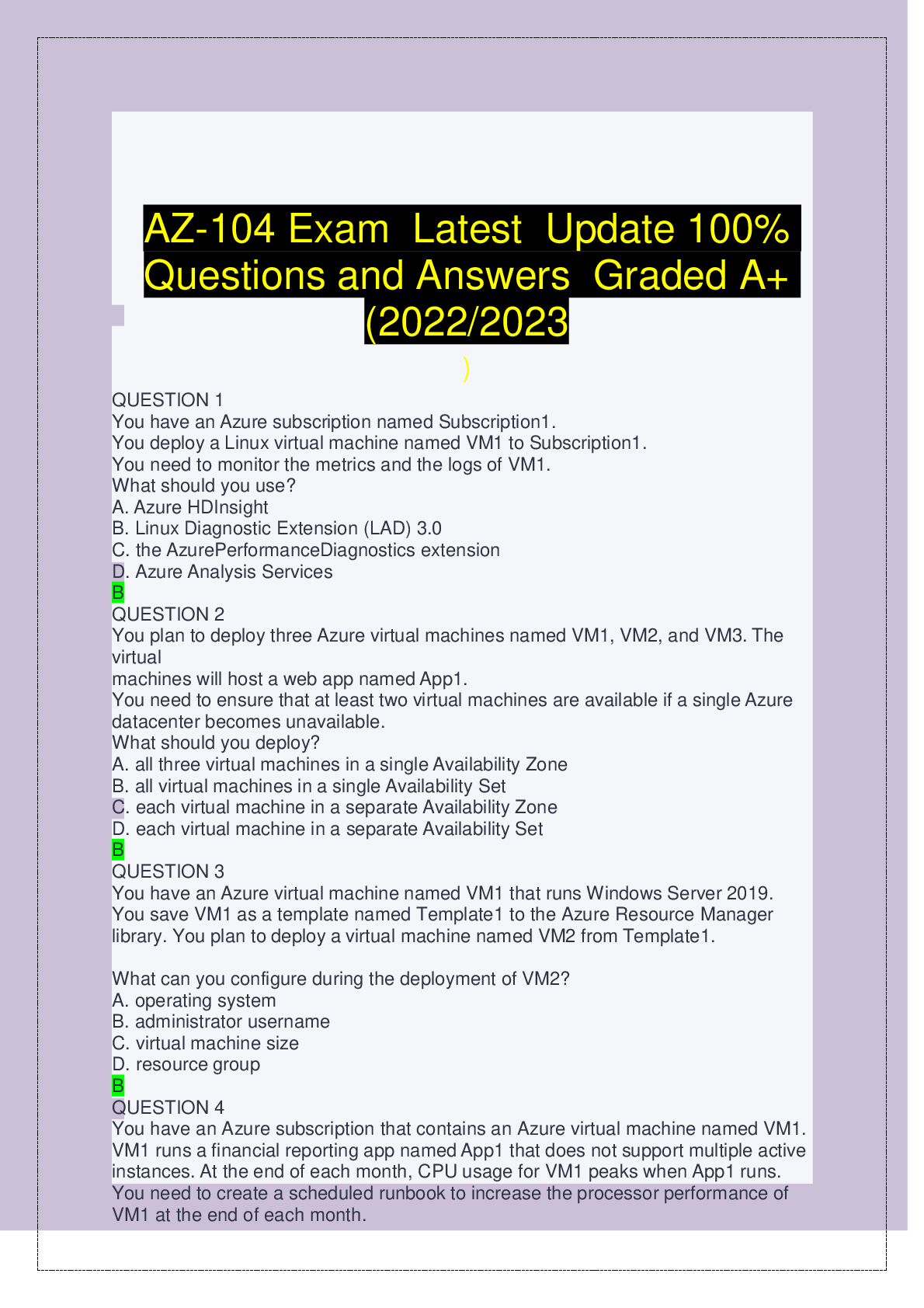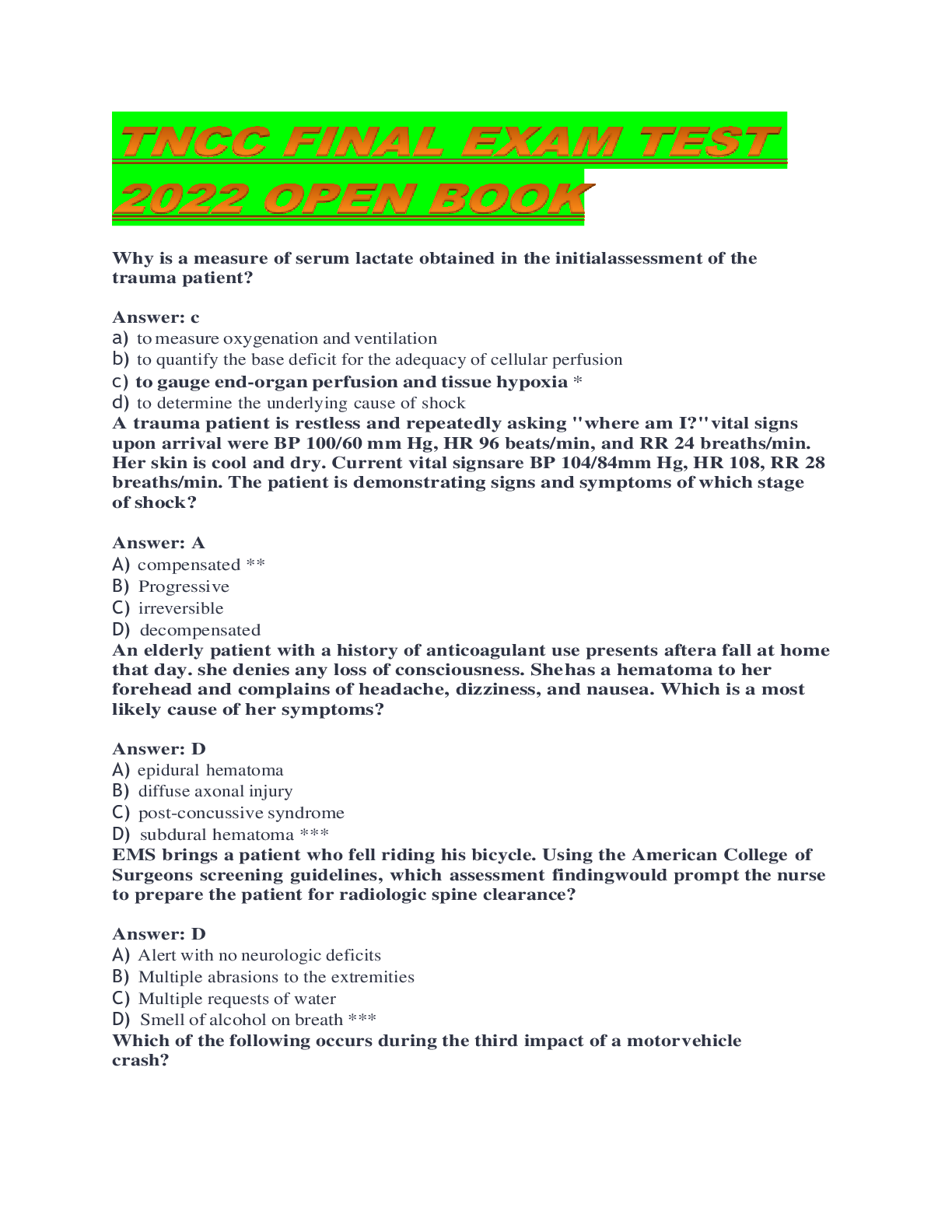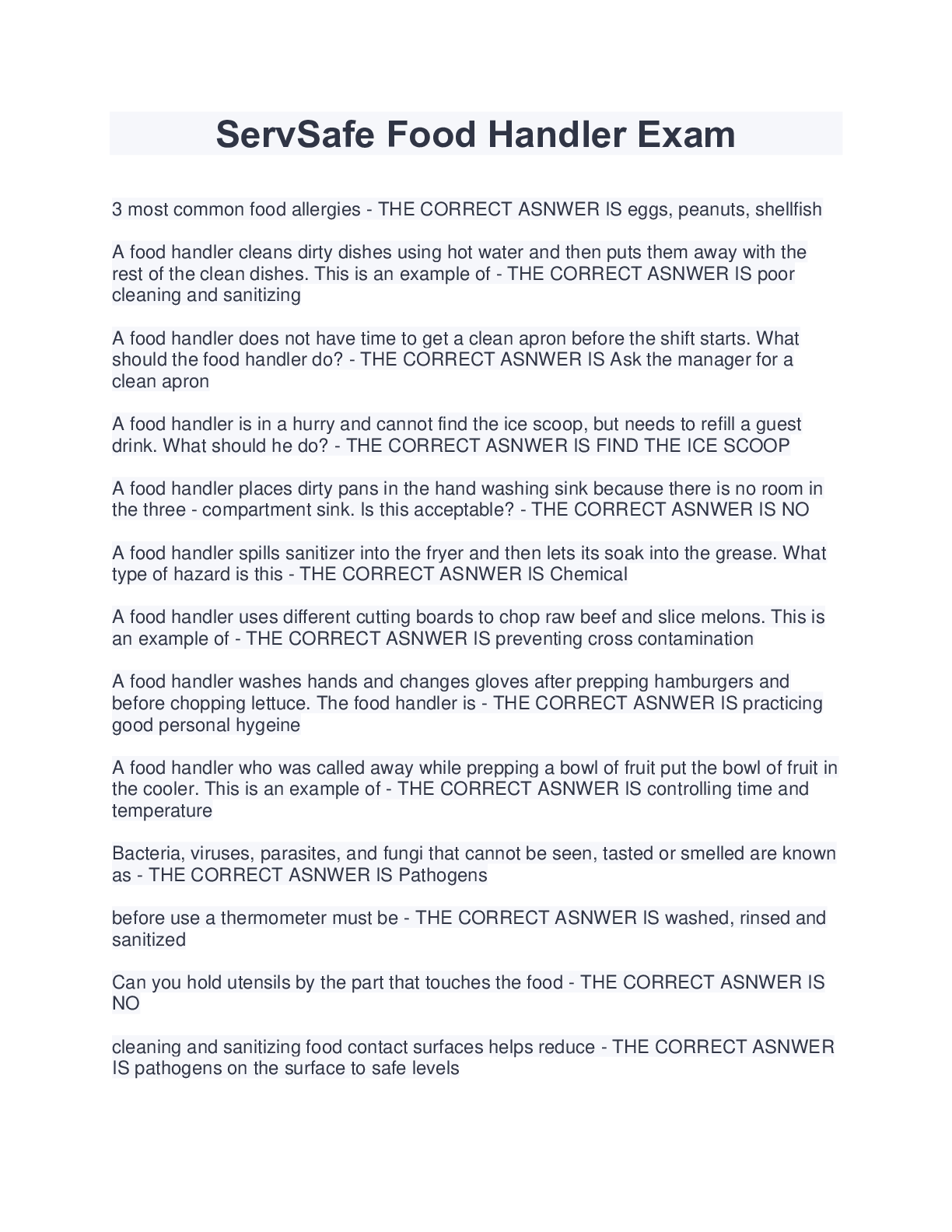*NURSING > EXAM > NR 222 - evolve exam 2 questions & Answers (Latest) Chamberlain College of Nursing; Already Graded A (All)
NR 222 - evolve exam 2 questions & Answers (Latest) Chamberlain College of Nursing; Already Graded A+
Document Content and Description Below
Chamberlain College of Nursing - NR 222 Evolve exam NR 222 Evolve exam 2 questions & Answers CHp9 evolve quiz 1. A nurse enters the examination room of the emergency clinic and meets a 29-year-o... ld patient who missed her last two follow-up appointments. The nurse notes from the medical record that the patient has high blood pressure that the doctor has been trying to help her manage. The patient just spoke with her doctor who left the room frustrated because the patient has not been taking her medication as prescribed. The patient confronts the nurse, saying, “I'm tired of being treated this way; no one cares. I need to find another doctor!” Using the C-LARA mnemonic, match the nurse's response to the correct letter of the mnemonic 2. Which of the following are considered social determinants of health? (Select all that apply.) 1. Lack of primary health care providers in a zip code 2. Poor-quality public school education that prevents a person from developing adequate reading skills 3. Lack of affordable health insurance 4. Employment opportunities that do not provide paid vacation or sick leave 5. The number of times a person exercises during a week 6. Neighborhood safety that prevents a person from walking around the block or socializing with neighbors outside of his or her home ABCDF The social determinants of health are the circumstances in which people are born and grow up; the neighborhood in which they live, work, and age; and the systems put in place to deal with illness. These circumstances are in turn shaped by a wider set of forces: economics, social policies, and politics. 3. Which of the following changes can help create a more inclusive environment for lesbian, gay, bisexual, and transgender (LGBT) patients? (Select all that apply.) 1. Explicitly including sexual orientation and gender identity into nondiscrimination policies 2. Displaying art that reflects LGBT community 3. Modifying health care forms to provide opportunities for gender identity and sexual orientation disclosure 4. Not asking patients about their gender identity and sexual orientation to avoid making them uncomfortable 5. Ensuring access to unisex or single-stall bathrooms 114 ABCE All of these help to create a more inclusive environment for LGBT patients. It is important to ask patients about their gender identity and sexual orientation to avoid making them uncomfortable. 4. Which of the following are examples of problems with the health care system that contribute to health disparities? (Select all that apply.) 1. A health care provider assumes that the patient missed two appointments because the patient does not care about his or her health and does not inquire about the reasons for missed visits. 2. The discharge nurse at a hospital uses Teach Back with a patient to ensure that she has communicated the discharge instructions clearly. 3. A community hospital lacks an adequate staff of social workers who are able to ensure patients' access to resources they need to take care of their health. 4. A hospital discharges a patient without ensuring that the patient has a primary care provider and has made a follow-up appointment. 5. A nurse uses a family member as an interpreter to explain the patient's medications. 6. The hospital conducts quality improvement without stratifying data by race, ethnicity, language, socioeconomic status, sexual orientation, and other axes of social group identities. ACDEF A large body of research shows that health care systems and health care providers contribute significantly to the problem of health disparities. Inadequate resources (lack of social workers), poor patient-provider communication (discharge instructions), a lack of culturally competent care, system fragmentation (not ensuring that the patient has a primary care provider or a follow-up appointment), and inadequate language access (use of interpreters) are critical factors that contribute to inequities in patient outcomes. RESPECT is the mnemonic for Rapport, Empathy, Support, Partnership, Explorations, Cultural competence, Trust 5. Match each letter of the RESPECT mnemonic with a statement that describes the concept the letter represents. 6. A patient is admitted through the emergency department (ED) after a serious car accident. The nurse assesses the patient and quickly learns that he speaks little English. Spanish is his primary language. The nurse speaks some Spanish. Which interventions would be appropriate at this time? (Select all that apply.) 1. The nurse requests a professional interpreter. 2. Since this is an emergent situation, the nurse will interpret and identify the patient's priority needs. 3. The nurse determines the interpreter's qualifications and makes sure that the interpreter can speak the patient's dialect. 4. The nurse uses short sentences to explain the treatments provided in the ED. 5. The nurse directs questions to the patient by looking at the patient instead of at the interpreter. ACDE In any situation the nurse should use an interpreter and not the family to convey information to the patient. As the nurse you need to question the interpreter about his or her ability to speak the patient's dialect. It is your responsibility to introduce the interpreter to the patient. You are communicating with the patient and should direct your questions and responses to the patient and not the interpreter. Short sentences make it easier for the patient to understand complex information 7. A new nurse is caring for a hospitalized obese patient who is homeless. This is the first time the patient has been admitted to the hospital, and the patient is scheduled for surgery. Which of the following is a universal skill that will help the nurse work effectively with this patient? 1. The nurse shifts her focus to understanding the patient by asking her, “Describe for me the course of your illness.” 2. The nurse tells the patient, “Your choices of foods and unwillingness to exercise are adding to your health problems.” 3. The nurse asks the patient, “Tell me about the main problems you have had with your health from not having a home.” 4. The nurse explains, “Because you have obesity, it is important to know the effects it has on wound healing because of reduced tissue perfusion.” 8. Which statement made by a new graduate nurse about the teach-back technique requires intervention and further instruction by the nurse's preceptor? 1. “After teaching a patient how to use an inhaler, I need to use the Teach Back technique to test my patient's understanding.” 2. “The Teach Back technique is an ongoing process of asking patients for feedback.” 3. “Using Teach Back will help me identify explanations and communication strategies that my patients will most commonly understand.” 4. “Using pictures, drawings, and models can enhance the effectiveness of the Teach Back technique.” 9. In the United States, there has never been a president of Asian or Hispanic culture. This is an example of: 1. Social inequality 2. Marginalization 3. Under inclusion 4. Social location 10. A nurse has worked in a home health agency for a number of years. She goes to visit a patient who has diabetes and who lives in a public housing facility. This is the first time the nurse has cared for the patient. The patient has four other family members who live with her in the one-bedroom apartment. Which of the following, based on Campinha-Bacote's (2002) model of cultural competency, is an example of cultural awareness? 1. The nurse begins a discussion with the patient by asking, “Tell me about your family members who live with you?” 2. The nurse asks, “What do you believe is needed to make you feel better?” 3. The nurse silently reflects about how her biases regarding poverty can influence how she assesses the patient. 4. The nurse uses a therapeutic and caring approach to how she interacts with the patient. 12. A nurse is preparing to perform a cultural assessment of a patient. Which of the following questions is an example of a contrast question? 1. Tell me about your ethnic background. 2. Have you had this problem in the past? 3. Where do other members of your family live? 4. How different is this problem from the one you had previously? 13. How can a nurse work on developing cultural awareness? (Select all that apply.) 1. Reflect on his or her past learning about health, illness, race, gender, and sexual orientation 2. Develop greater self-knowledge about personal biases 3. Recognize consciously the multiple factors that influence his or her own world view 4. Engage in an in-depth self-examination of his or her own background 5. Learn as many facts as possible about an ethnic group 14. During an encounter with an elderly patient, the nurse recognizes that a thorough cultural assessment is necessary because the patient has recently come to the United States from Russia and has never been hospitalized before. The nurse wants to discuss cultural similarities between herself and the patient. Which step of the LEARN mnemonic is this? 1. Listen 2. Explain 3. Acknowledge 4. Recommend treatment 5. Negotiate agreement 15. When you care for a patient who does not speak English, it is necessary to call on a professional interpreter. Which of the following are proper principles for working with interpreters? (Select all that apply.) 1. Expect the interpreter to interpret your statements word-for-word so there is no misunderstanding by the patient. 2. If you feel an interpretation is not correct, stop and address the situation directly with the interpreter. 3. Pace a conversation so there is time for the patient's response to be interpreted. 4. Direct your questions to the interpreter. 5. Ask the patient for feedback and clarification at regular intervals. Chapter 10 1. The Collins family includes a mother; stepfather, two teenage biological daughters of the mother; and a 25-year-old biological daughter of the father. The father's daughter just moved home following the loss of her job in another city. The family is converting a study into Stacey's bedroom and is in the process of distributing household chores. When you talk to members of the family, they all think that their family can adjust to lifestyle changes. This is an example of family: 2. What is the most common reason for calling on grandparents to raise their grandchildren? 1. Single parenthood 2. Legal interventions 3. Dual-income families 4. Increased divorce rate 3. Which of the following most greatly affects a family's access to adequate health care, opportunity for education, and sound nutrition? 1. Development 2. Family function 3. Family structure 4. Economic stability 4. You are caring for a family that consists of a father and 3-year-old boy who has well-managed asthma but misses care infrequently. They live in state-supported housing. The father is in school studying to be an information technology professional. His income and time are limited, and he admits to going to fast-food restaurants frequently for dinner. However, he and his son spend a lot of time together. The family receives state-supported health care for his son, but he does not have health insurance or a personal physician. He has his son enrolled in a government-assisted day care program. Which of the following are risks to this family's level of health? (Select all that apply.) 1. Economic status 2. Chronic illness 3. Underinsured 4. Government-assisted day care 5. Frequency of fast-food dinners 6. State-supported housing 5. Which of the following family assessments are most important for successful family caregiving? (Select all that apply.) 1. Educational level of family members 2. Cultural food preferences 3. Collaboration between family members 4. Social support 5. Conflict resolution practices 6. Which of the following are possible outcomes with clear family communication? (Select all that apply.) 1. Family goals 2. Increased socialization 3. Decision making 4. Methods of discipline 5. Improved education 6. Impaired coping 7. A family has decided to care for a grandparent with terminal cancer in the daughter's home. Family caregiving is new to the 130family. When helping this family as they begin to plan for their caregiving roles, what are the two top priority assessments to best learn about family functioning? (Select all that apply.) 1. Communication 2. Decision making 3. Development 4. Economic status 5. Family structure 8. A family is facing job loss of the father, who is the major wage earner, and relocation to a new city where there is a new job. The children will have to switch schools, and his wife will have to resign from the job she likes. Which of the following contribute to this family's hardiness? (Select all that apply.) 1. Family meetings 2. Established family roles 3. New neighborhood 4. Willingness to change in time of stress 5. Passive orientation to life 9. A family is undergoing a major change. Just as twins graduate from college and leave home to begin their careers, the husband loses his executive well-paying job. Because the family had two children in college at the same time, they did not save for retirement. They planned to save aggressively after the children left college. In this situation, which of the following demonstrate family resiliency? (Select all that apply.) 1. Resuming full-time work when spouse loses job 2. Increasing problems among siblings 3. Developing hobbies when children leave home 4. Placing blame on family members 5. Expecting children to help financially 6. Consulting a financial planner 10. In viewing the family as context, what is the primary focus? 1. Family members within a system 2. Family process and relationships 3. Family relational and transactional concepts 4. Health needs of an individual member 11. A hospice nurse is caring for a family that is providing end-of-life care for their grandmother, who has terminal breast cancer. When the nurse visits, the focus is on symptom management for the grandmother and helping the family with coping skills. This approach is an example of which of the following? 1. Family as context 2. Family as patient 3. Family as system 4. Family as structure 12. A new immigrant family consisting of a grandparent, two adults, and three school-age children has decided to receive their health promotion care at the Community Wellness Center. This is their first visit, and a family assessment, a health history, and a physical of each family member are needed. Which of the following are included in a family function assessment? (Select all that apply.) 1. Cultural practices 2. Decision making 3. Neighborhood services 4. Rituals and celebrations 5. Neighborhood crime data 6. Availability of parks 13. Two single mothers are active professionals and have teenage daughters. They also have busy social lives and date occasionally. Three years ago they decided to share a house and housing costs, living expenses, and child care responsibilities. The children consider one another as their family. What type of family form does this represent? 1. Diverse family relationship 2. Blended family relationships 3. Extended family relationship 4. Alternative family relationship 14. During a visit to a family clinic, a nurse teaches a mother about immunizations, car-seat use, and home safety for an infant and toddler. Which type of nursing interventions are these? 1. Health promotion activities 2. Acute care activities 3. Restorative care activities 4. Growth and development care activities 15. A family has decided to care for their father who is in the last stages of a debilitating neurological illness. Although he is alert, he cannot speak clearly or carry out self-care activities; he indicates that he wants to remain involved in family life as long as possible and loves spending time with his wife and two teenage children. Which best defines family caregiving? (Select all that apply.) 1. Designing a nurturing family to raise children 2. Providing physical and emotional care for a family member 3. Establishing a safe physical environment for a family 4. Monitoring for side effects of illness and treatments 5. Reducing the use of community resources Chapter 25 1. A patient needs to learn to use a walker. Which domain is required for learning this skill? 1. Affective domain 2. Cognitive domain 3. Attentional domain 4. Psychomotor domain Answer: 4. Using a walker requires the integration of mental and muscular activity. 2. The nurse is planning to teach a patient about the importance of exercise. When is the best time for teaching to occur? (Select all that apply.) 1. When there are visitors in the room 2. When the patient states that he or she is pain free 3. Just before lunch, when the patient is most awake and alert 4. When the patient is talking about current stressors in his or her life 5. When the patient is being transported for a procedure Answer: 2, 3. Plan teaching when the patient is most attentive, receptive, alert, and comfortable. 3. A patient newly diagnosed with cervical cancer is going home. The patient is avoiding discussion of her illness and postoperative orders. What is the nurse's best plan in teaching this patient? 1. Teach the patient's spouse 2. Focus on knowledge the patient will need in a few weeks 3. Provide only the information that the patient needs to go home 4. Convince the patient that learning about her health is necessary Answer: 3. This patient is in denial; thus it is appropriate to only give her information that is needed immediately. 4. The ______________ is a closed-loop communication technique used to evaluate patient understanding and retention of material. Answer: Teach-back method. Teach-back is a closed loop communication technique that assesses patient retention of the information imparted during a teaching session. 5. When planning for instruction on cardiac diets to a patient with heart failure, which of the following instructional methods would be the most appropriate for someone identified as a visual/spatial learner? 1. Printed pamphlets on cardiovascular disease and dietary recommendations from the American Heart Association 2. A role-play activity requiring the patient to select proper foods from a wide selection 3. Colored visual diagrams that categorize foods according to fat and sodium content 4. A lecture-style discussion on heart healthy diet options Answer: 3. Patients who are visual-spatial learners enjoy learning through pictures, visual charts, or any exercise that allows them to visualize concepts. 6. A patient with chest pain is having an emergency cardiac catheterization. Which teaching approach does the nurse use in this situation? 1. Telling approach 2. Selling approach 354 3. Entrusting approach 4. Participating approach Answer: 1. The telling approach is most appropriate when preparing a patient for an emergency procedure. 7. The nurse is organizing a disease prevention program for a specific cultural group. To effectively meet the needs of this group the nurse will: (Select all that apply.) 1. Assess the needs of the community in general. 2. Involve those affected by the problem in the planning process. 3. Develop generalized goals and objectives for the program. 4. Use educational materials that are simplistic and have many pictures. 5. Assess commonly held health beliefs among the cultural group. 6. Educate the specific cultural group about Western concepts of health and illness. 7. Include cultural practices that are relevant to the specific community 8. An older adult is being started on a new antihypertensive medication. In teaching the patient about the medication, the nurse: 1. Speaks loudly. 2. Presents the information once. 3. Expects the patient to understand the information quickly. 4. Allows the patient time to express himself or herself and ask questions 9. A patient needs to learn how to administer a subcutaneous injection. Which of the following reflects that the patient is ready to learn? 1. Describing difficulties a family member has had in taking insulin 2. Expressing the importance of learning the skill correctly 3. Being able to see and understand the markings on the syringe 4. Having the dexterity needed to prepare and inject the medication 10. A patient who is hospitalized has just been diagnosed with diabetes. He is going to need to learn how to give himself injections. Which teaching method does the nurse use? 1. Simulation 2. Demonstration 3. Group instruction 4. One-on-one discussion 11. When a nurse is teaching a patient about how to administer an epinephrine injection in case of a severe allergic reaction, the nurse tells the patient to hold the injection like a dart. Which of the following instructional methods did the nurse use? 1. Telling 2. Analogy 3. Demonstration 4. Simulation 12. A nurse needs to teach a young woman newly diagnosed with asthma how to manage her disease. Which of the following topics does the nurse teach first? 1. How to use an inhaler during an asthma attack 2. The need to avoid people who smoke to prevent asthma attacks 3. Where to purchase a medical alert bracelet that says she has asthma 4. The importance of maintaining a healthy diet and exercising regularly 13. A nurse is teaching a group of young college-age women the importance of using sunscreen when going out in the sun. Which type of content is the nurse providing? 1. Simulation 2. Restoring health 3. Coping with impaired function 4. Health promotion and illness prevention 14. A nurse is planning a teaching session about healthy nutrition with a group of children who are in first grade. The nurse determines that after the teaching session the children will be able to name three examples of foods that are fruits. This is an example of: 1. A teaching plan. 2. A learning objective. 3. Reinforcement of content. 4. Enhancing the children's self-efficacy 15. A nurse is teaching a 27-year-old gentleman how to adjust his insulin dosages on the basis of his blood sugar results. This type of activity addresses learning in the cognitive domain at the level of ___________. [Show More]
Last updated: 1 year ago
Preview 1 out of 20 pages
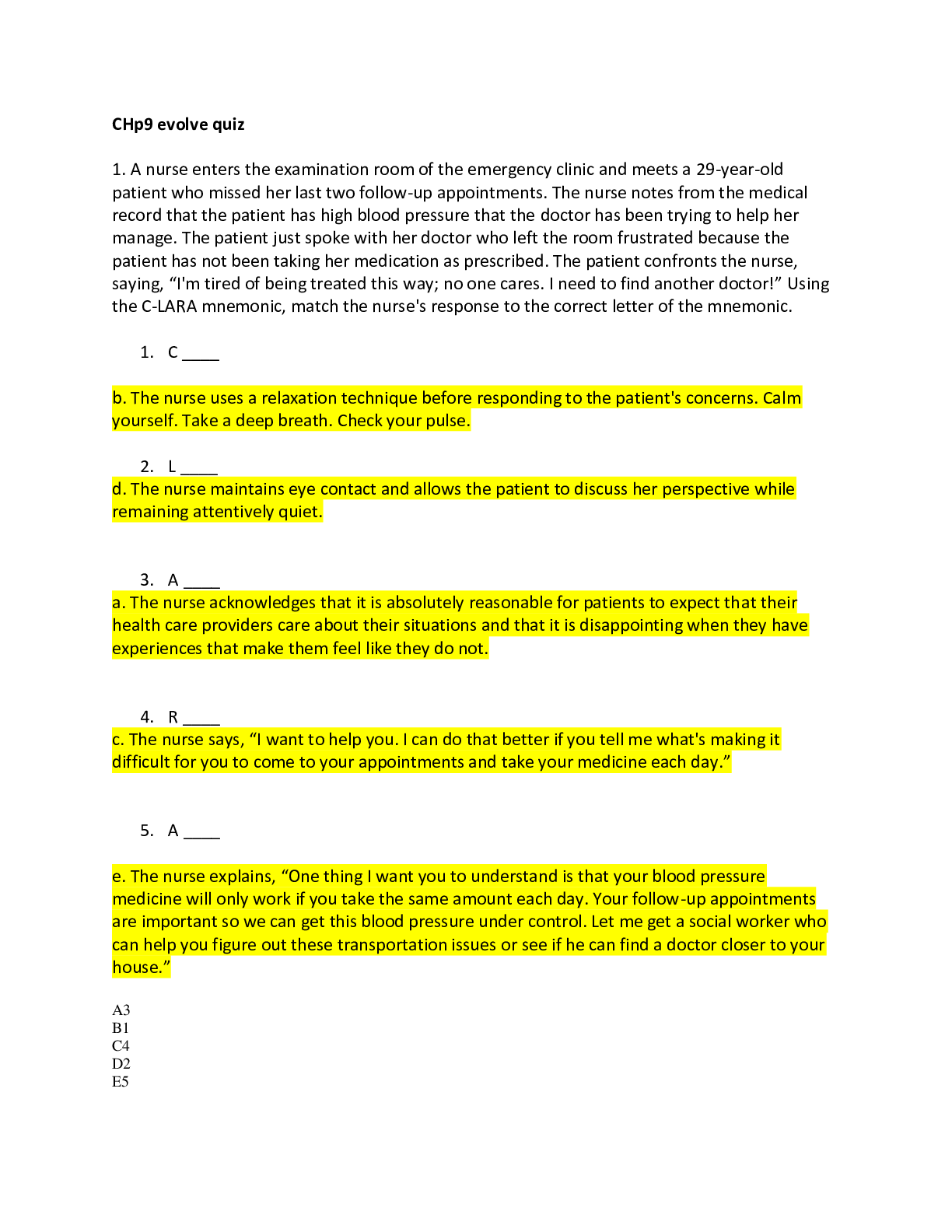
Reviews( 0 )
Document information
Connected school, study & course
About the document
Uploaded On
Oct 30, 2019
Number of pages
20
Written in
Additional information
This document has been written for:
Uploaded
Oct 30, 2019
Downloads
0
Views
69

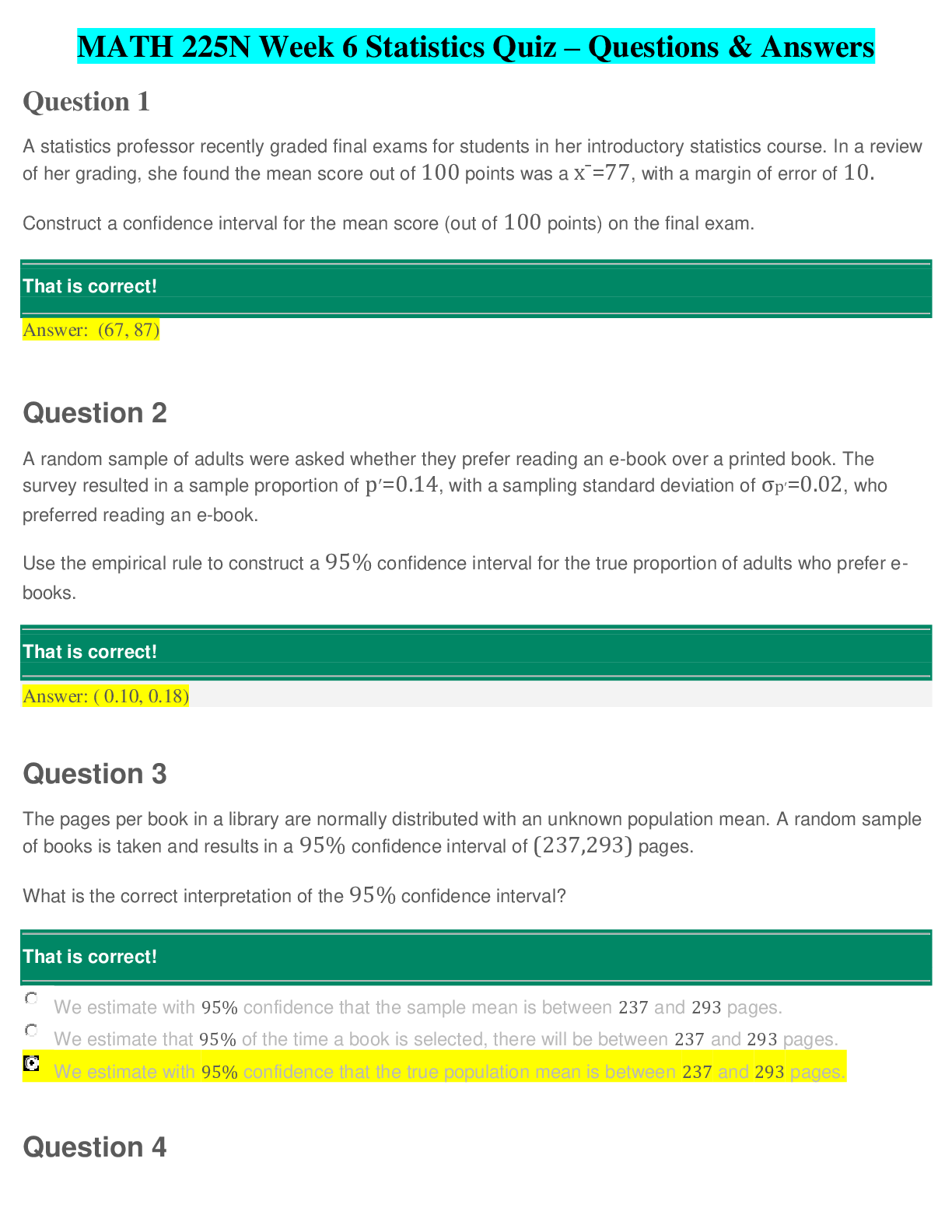
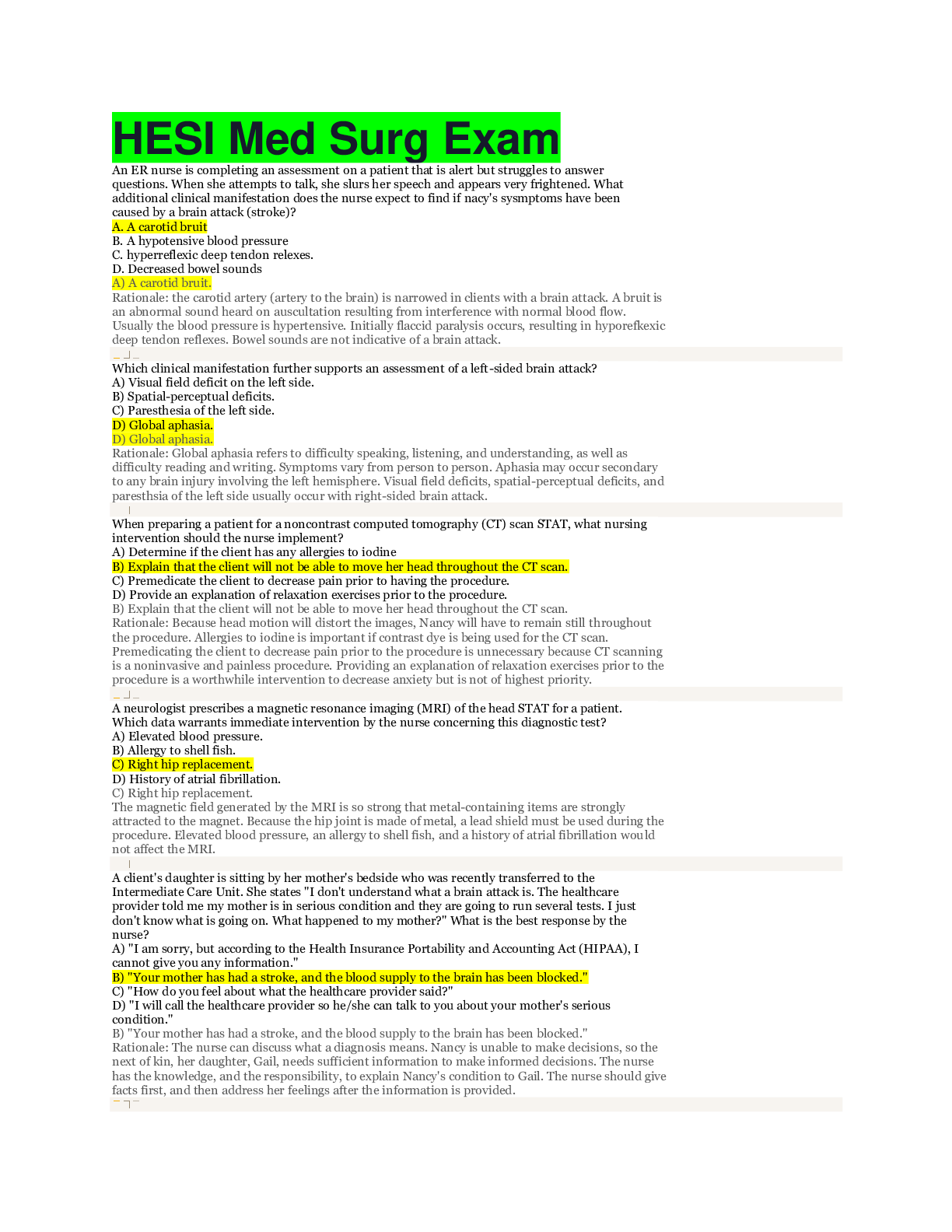
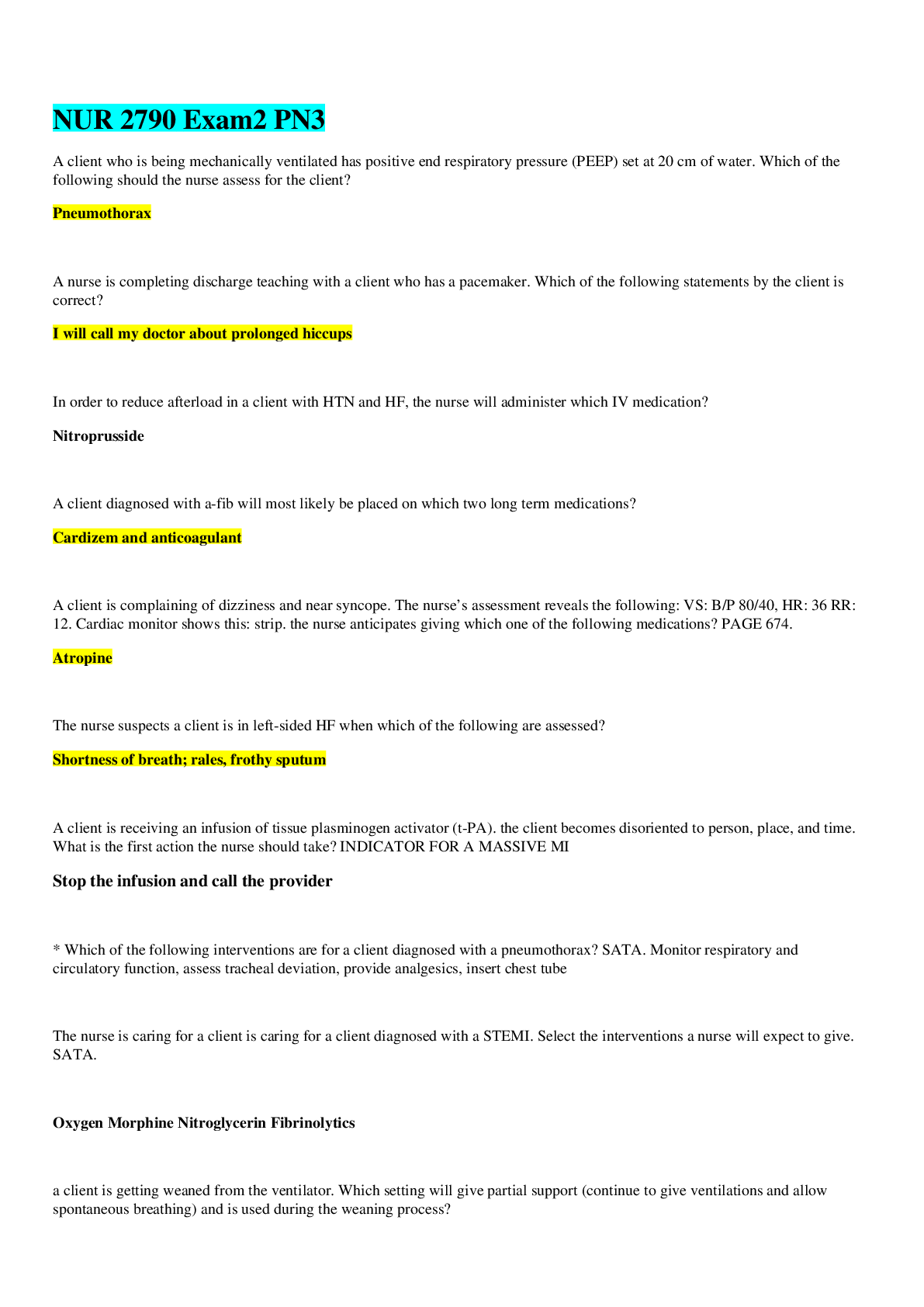
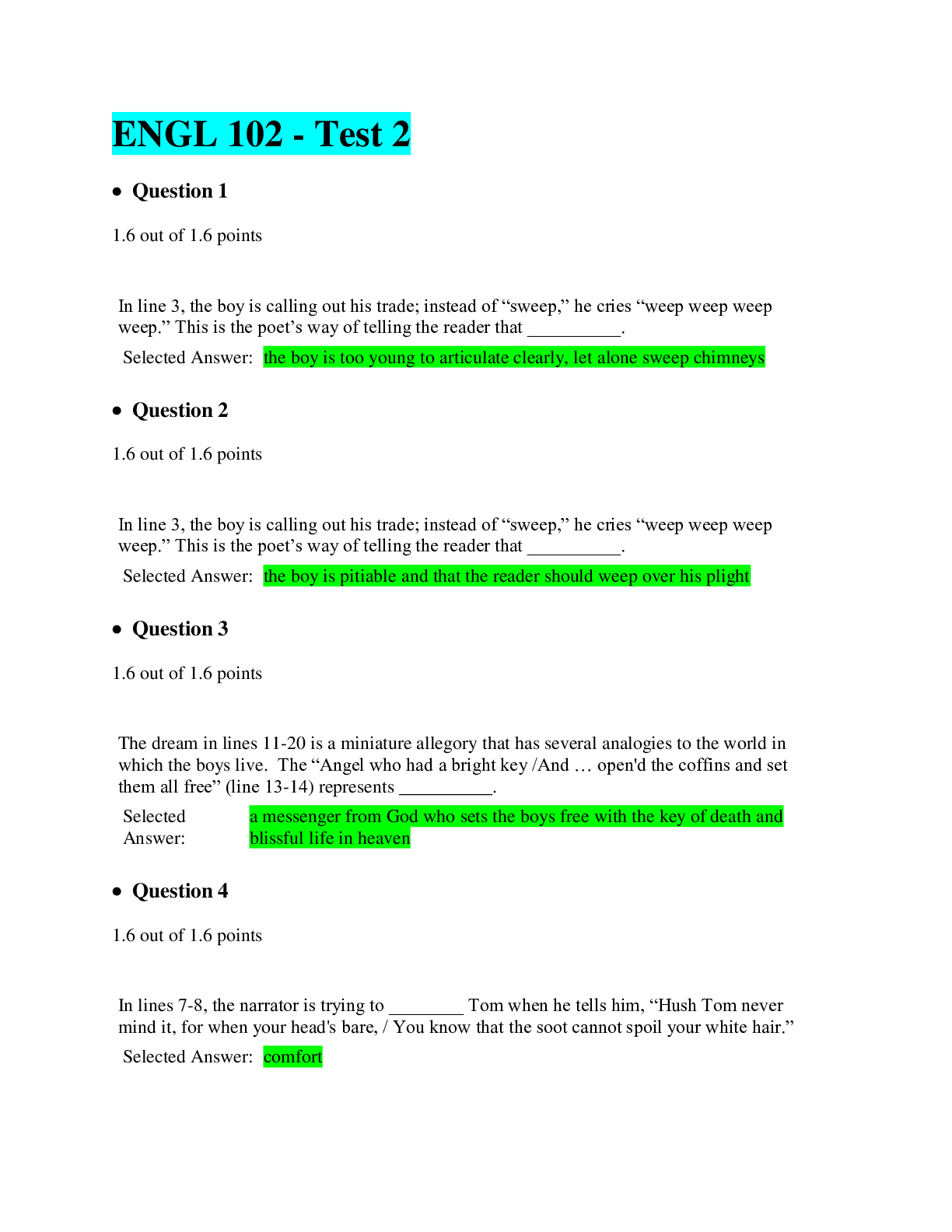
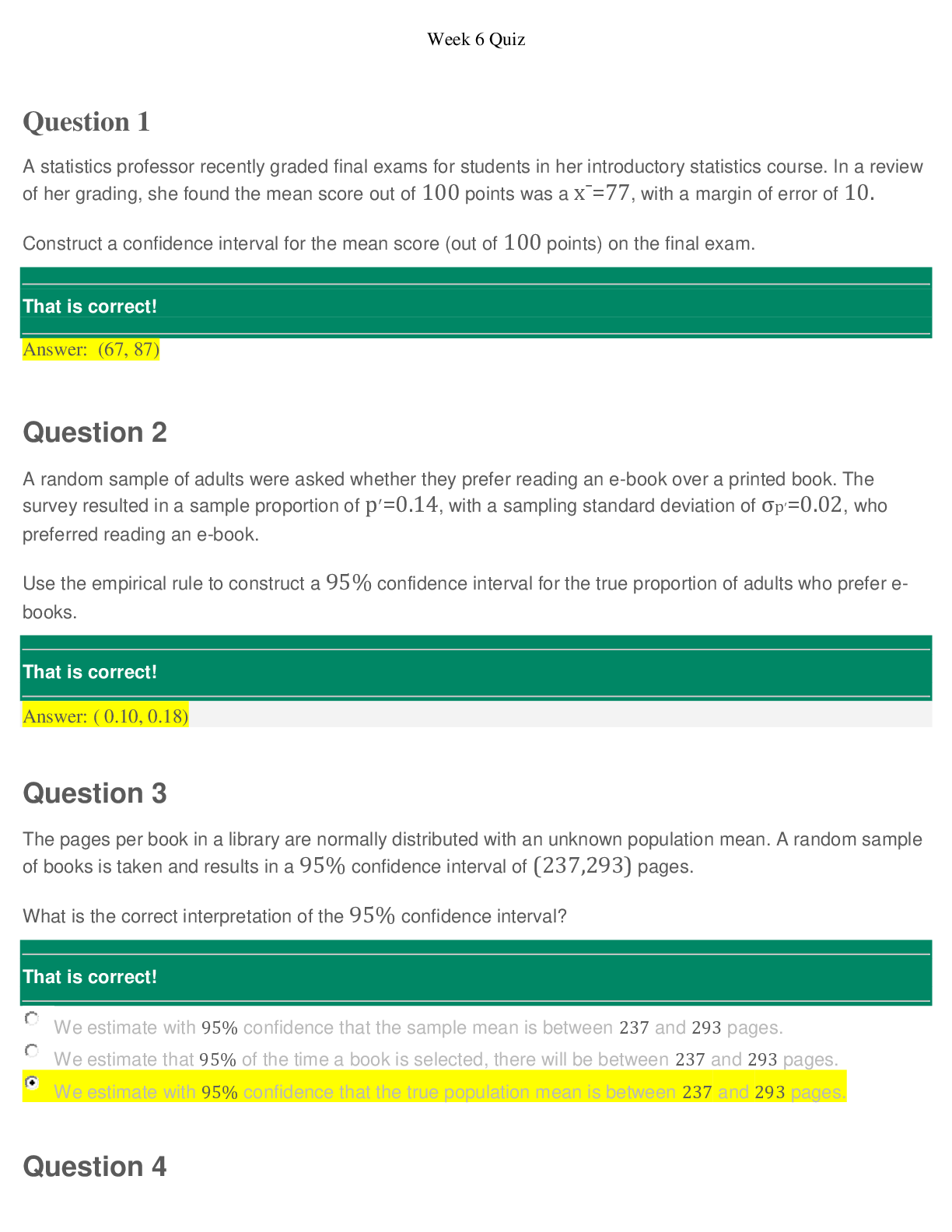

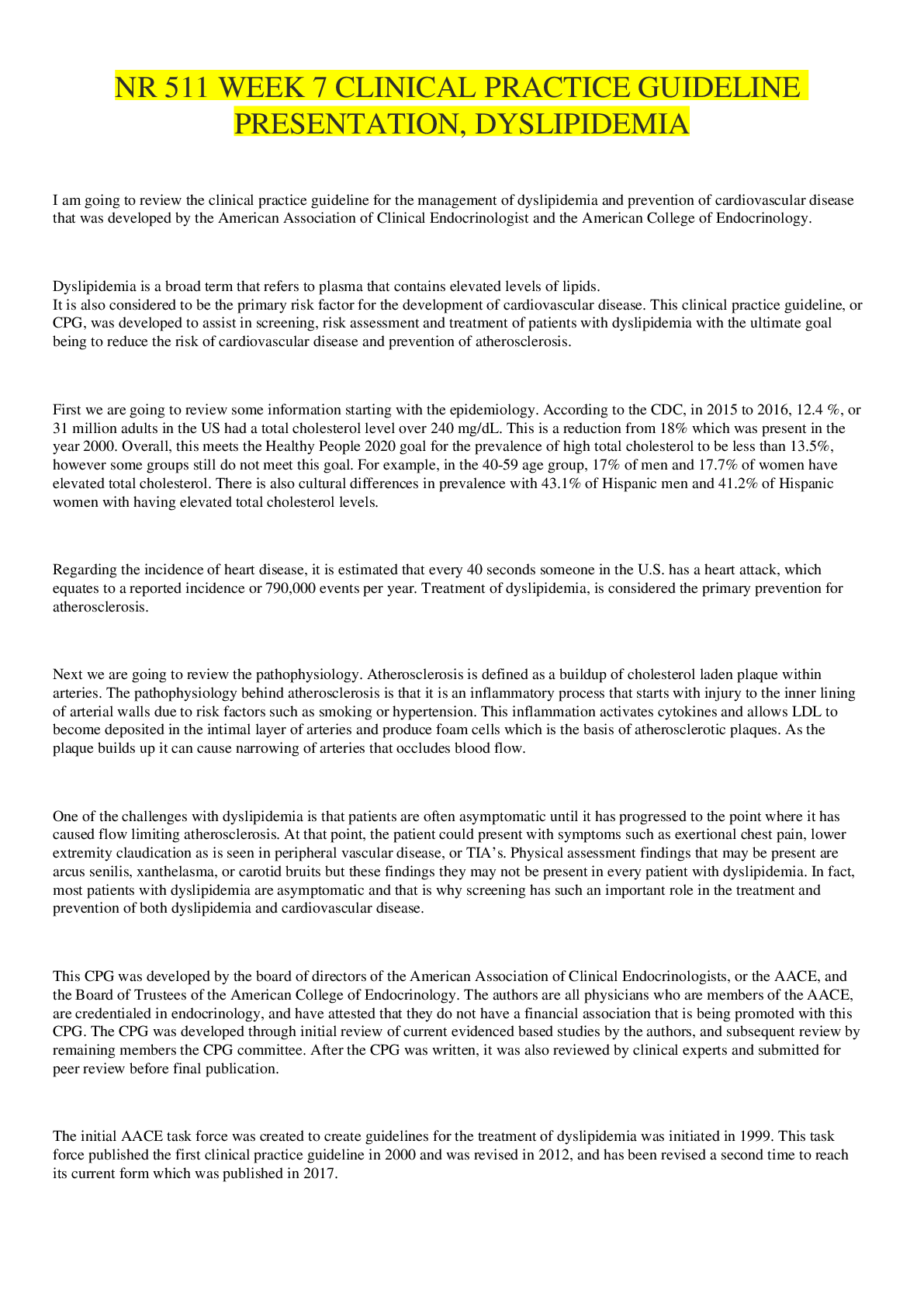
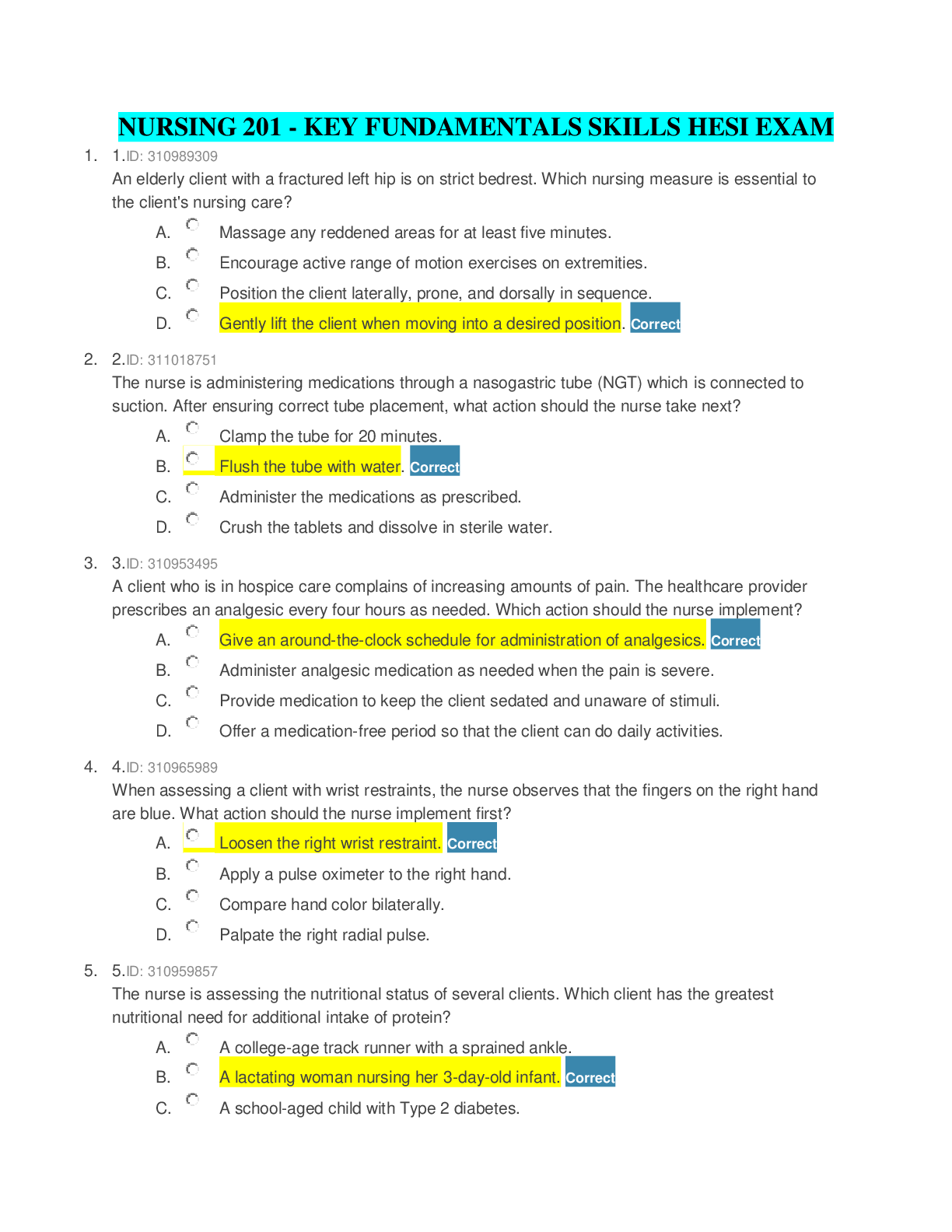
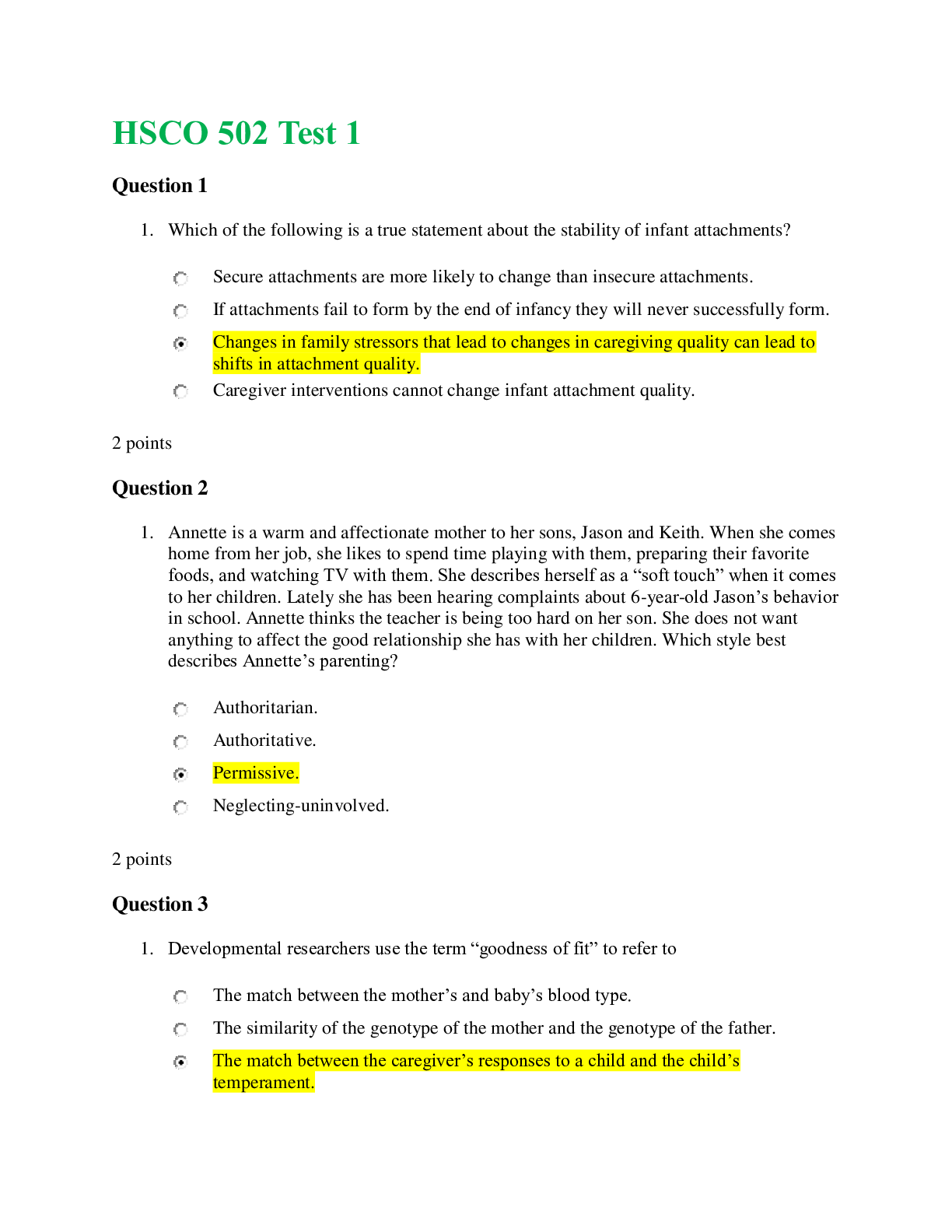

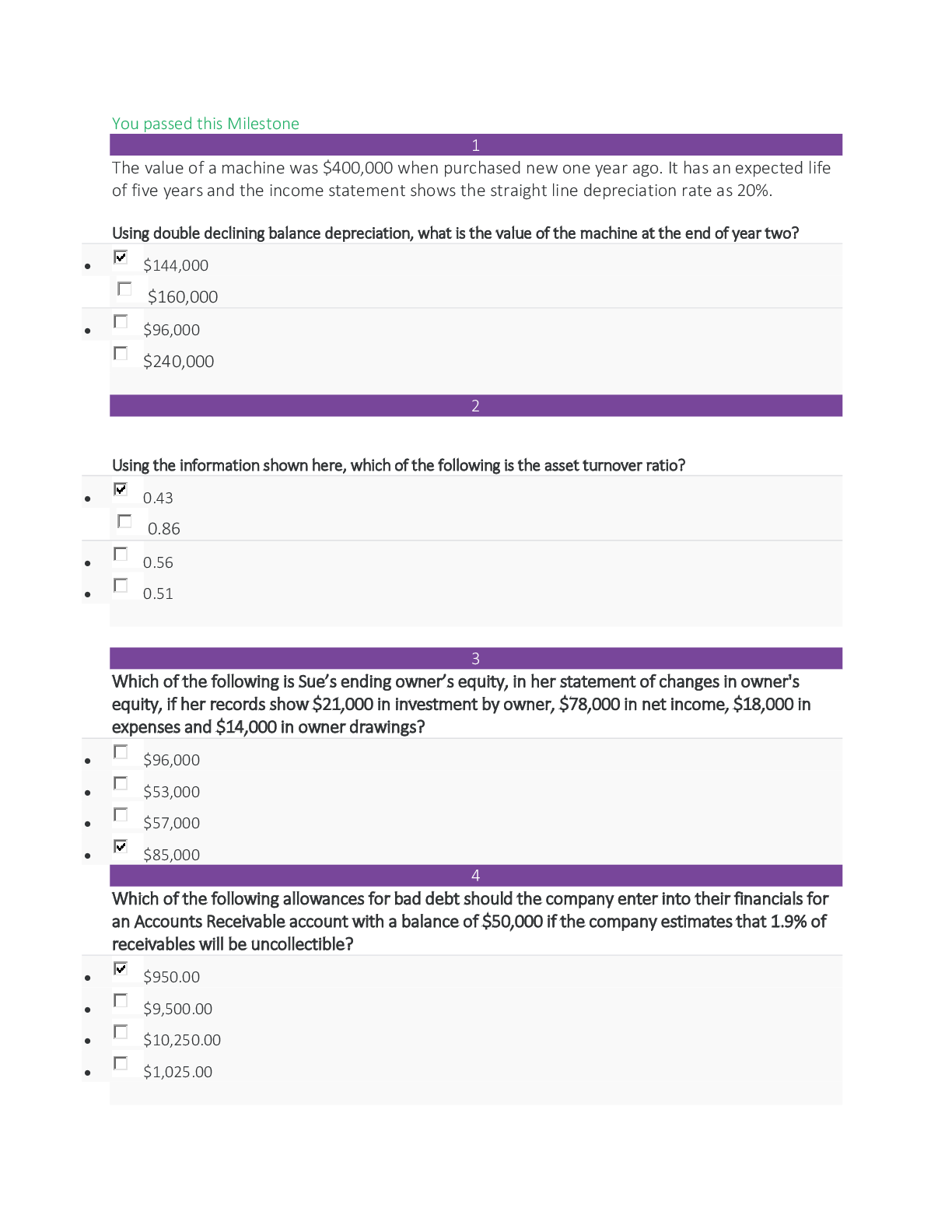
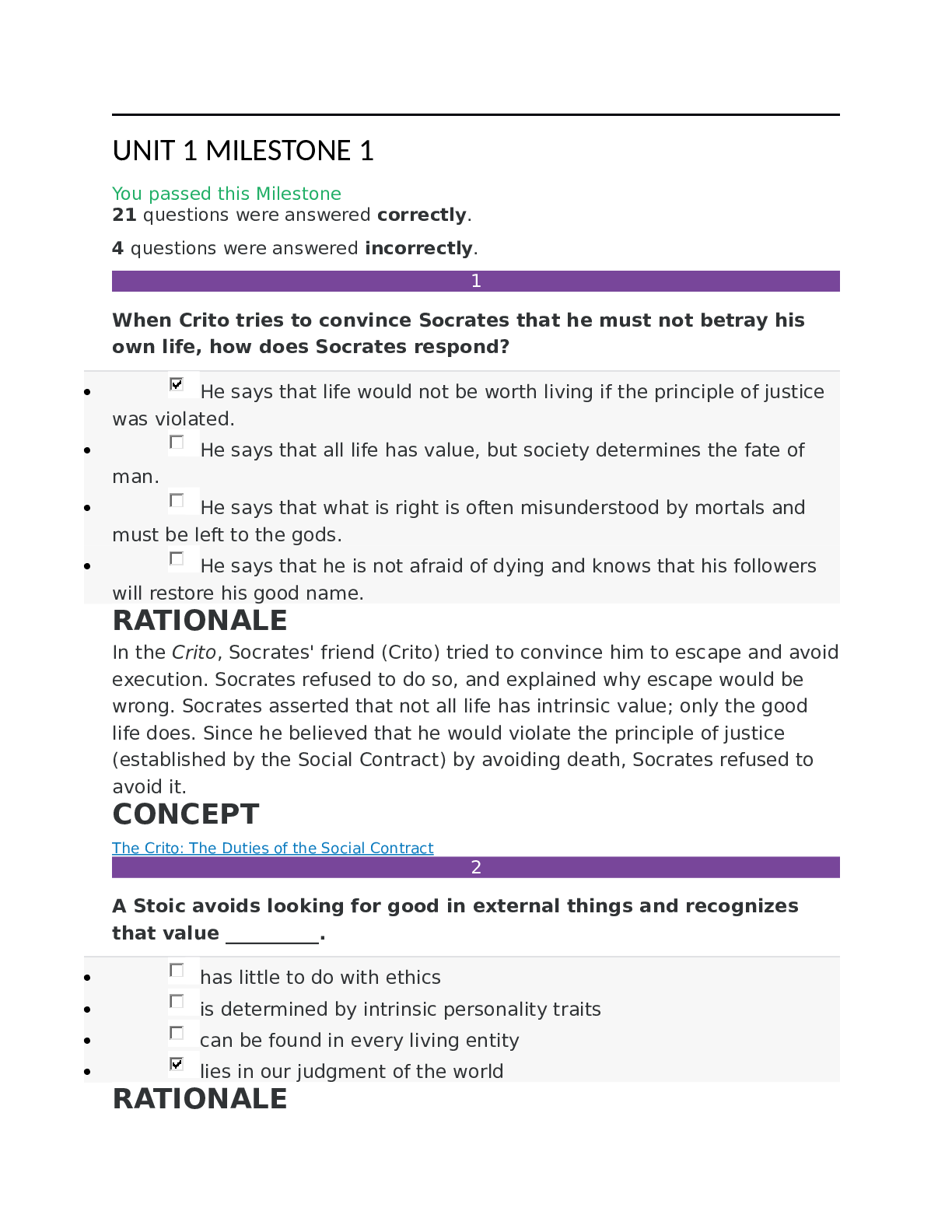
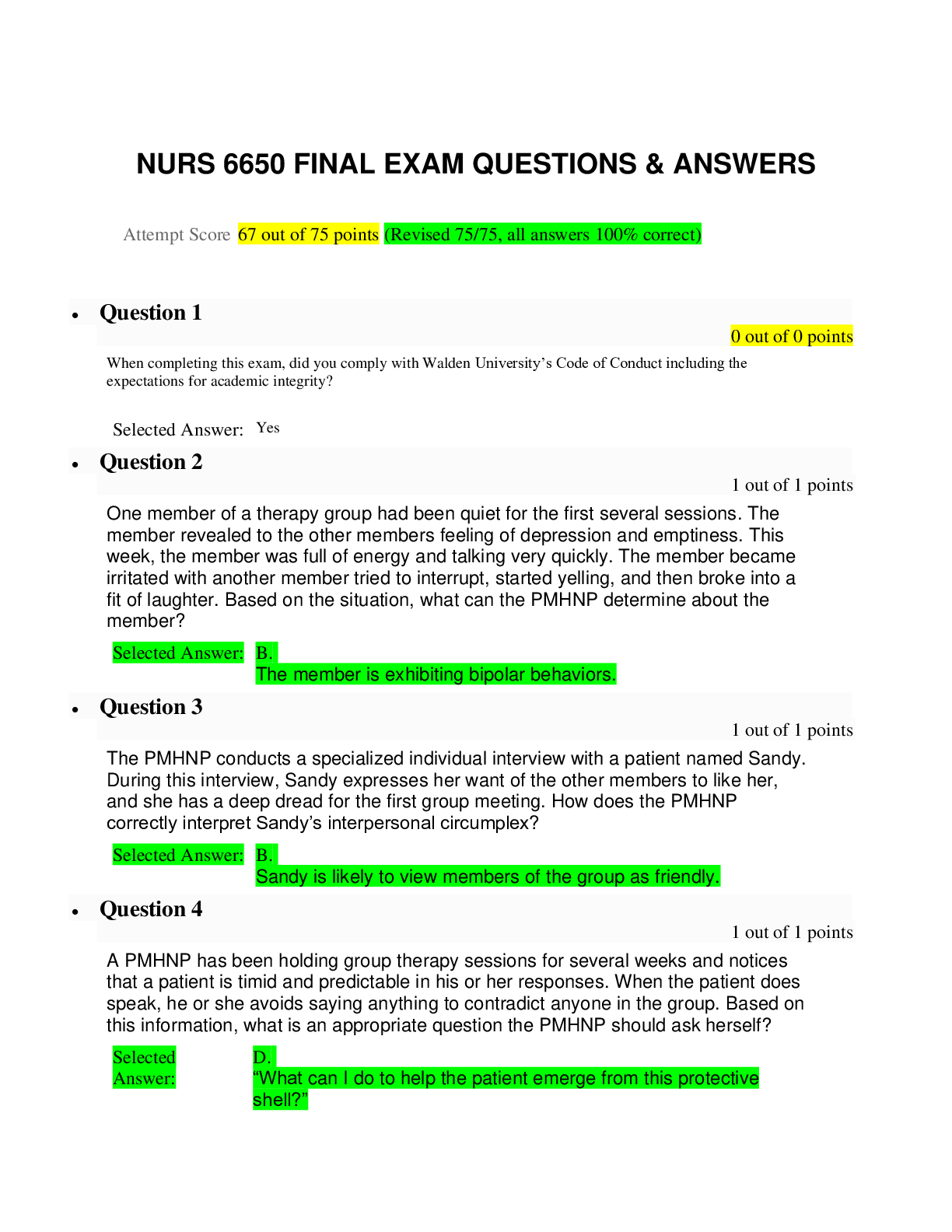
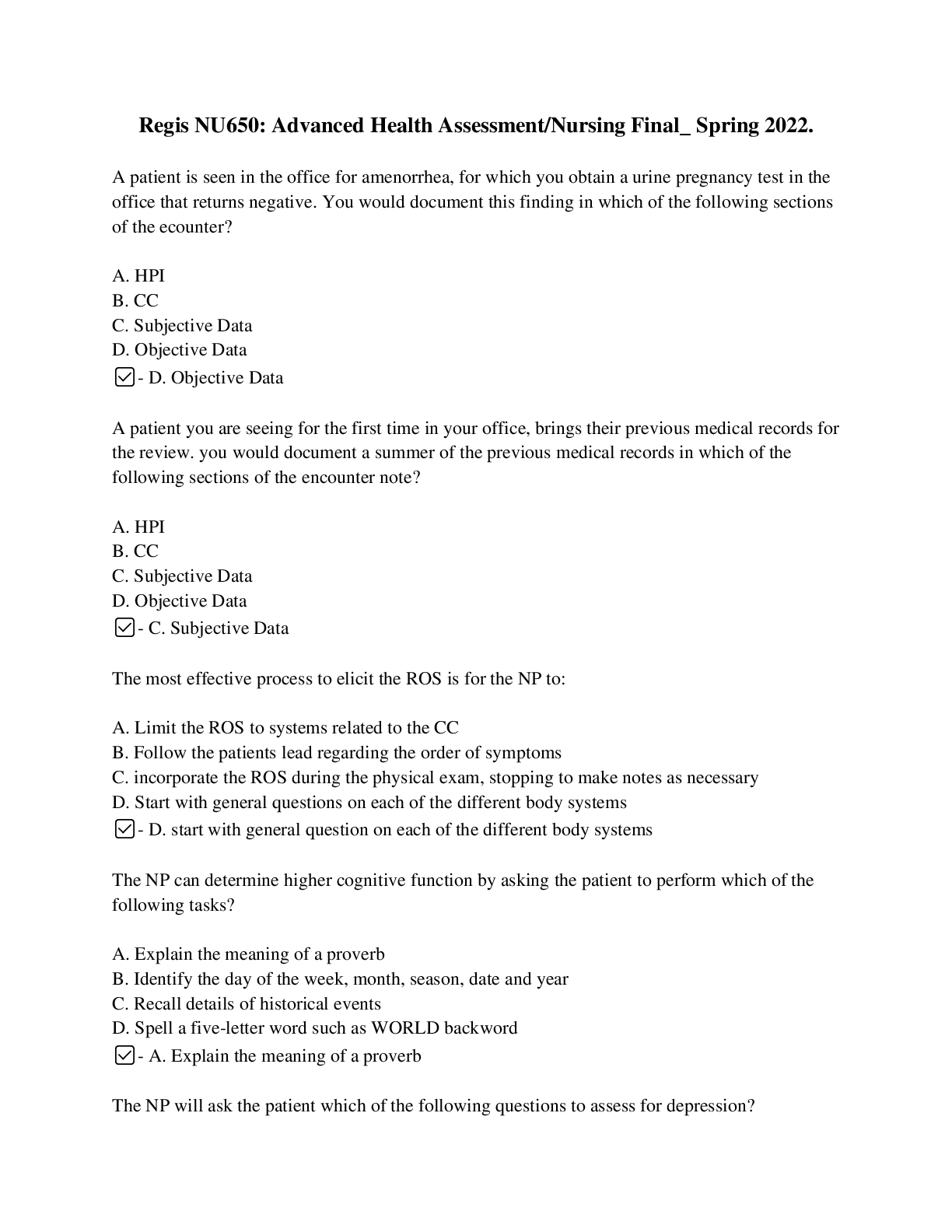
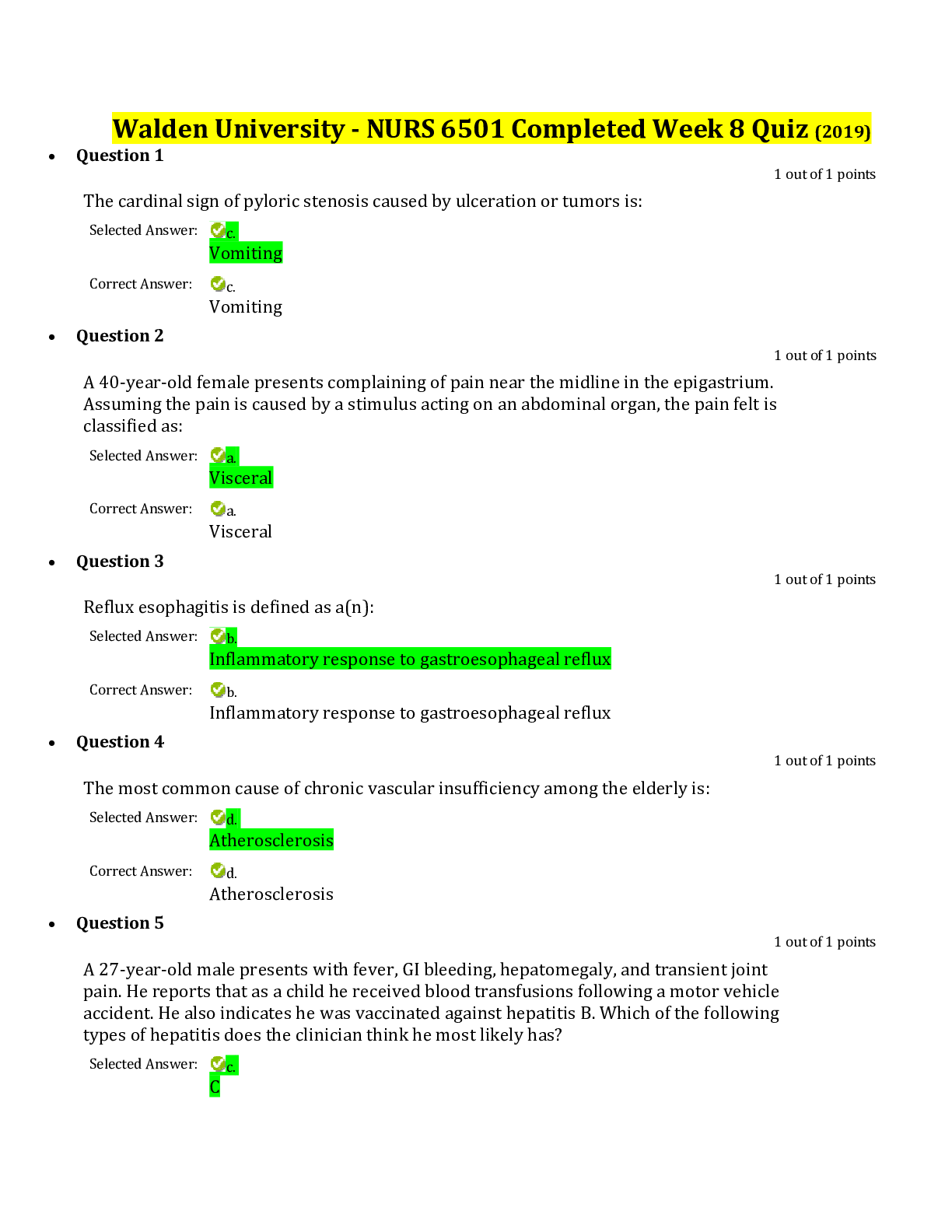
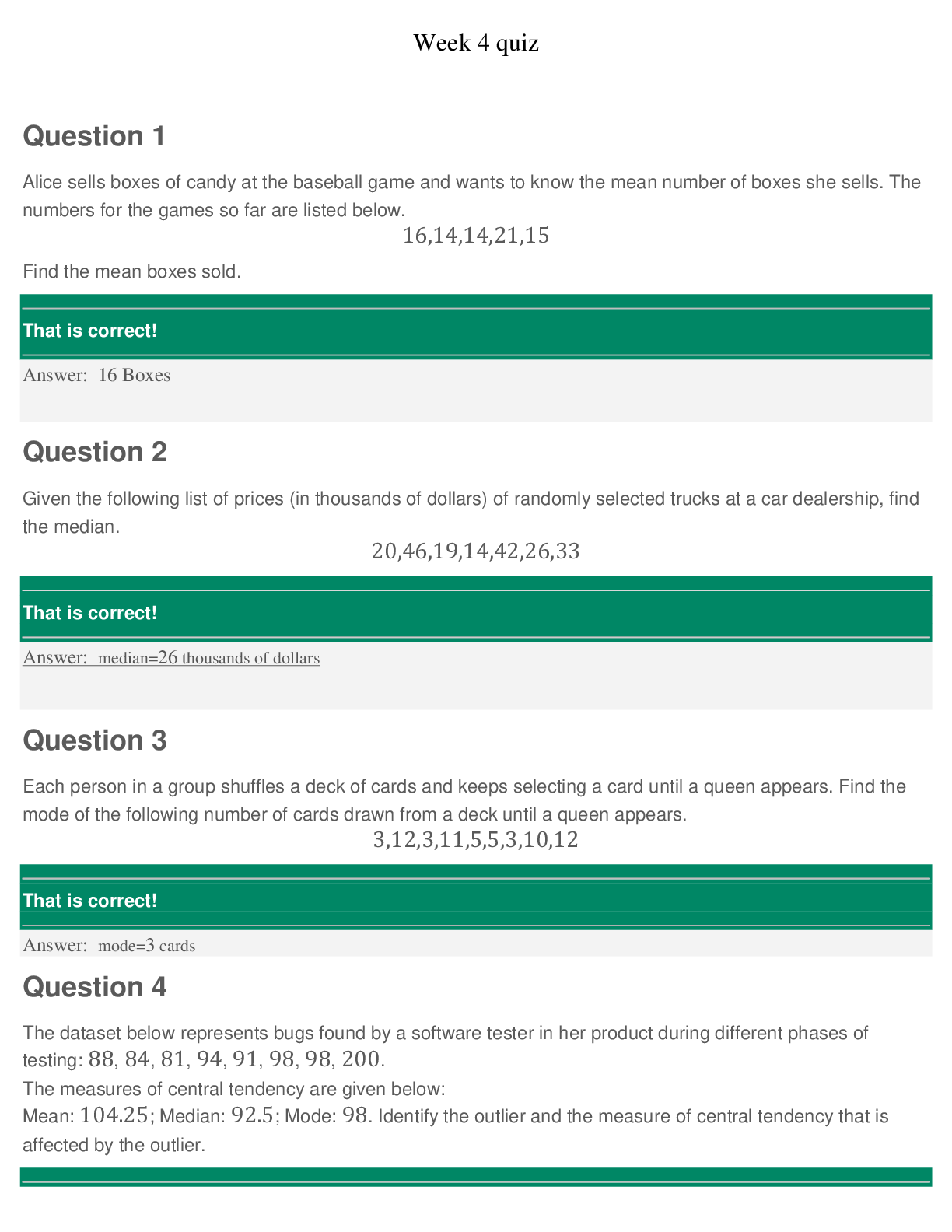
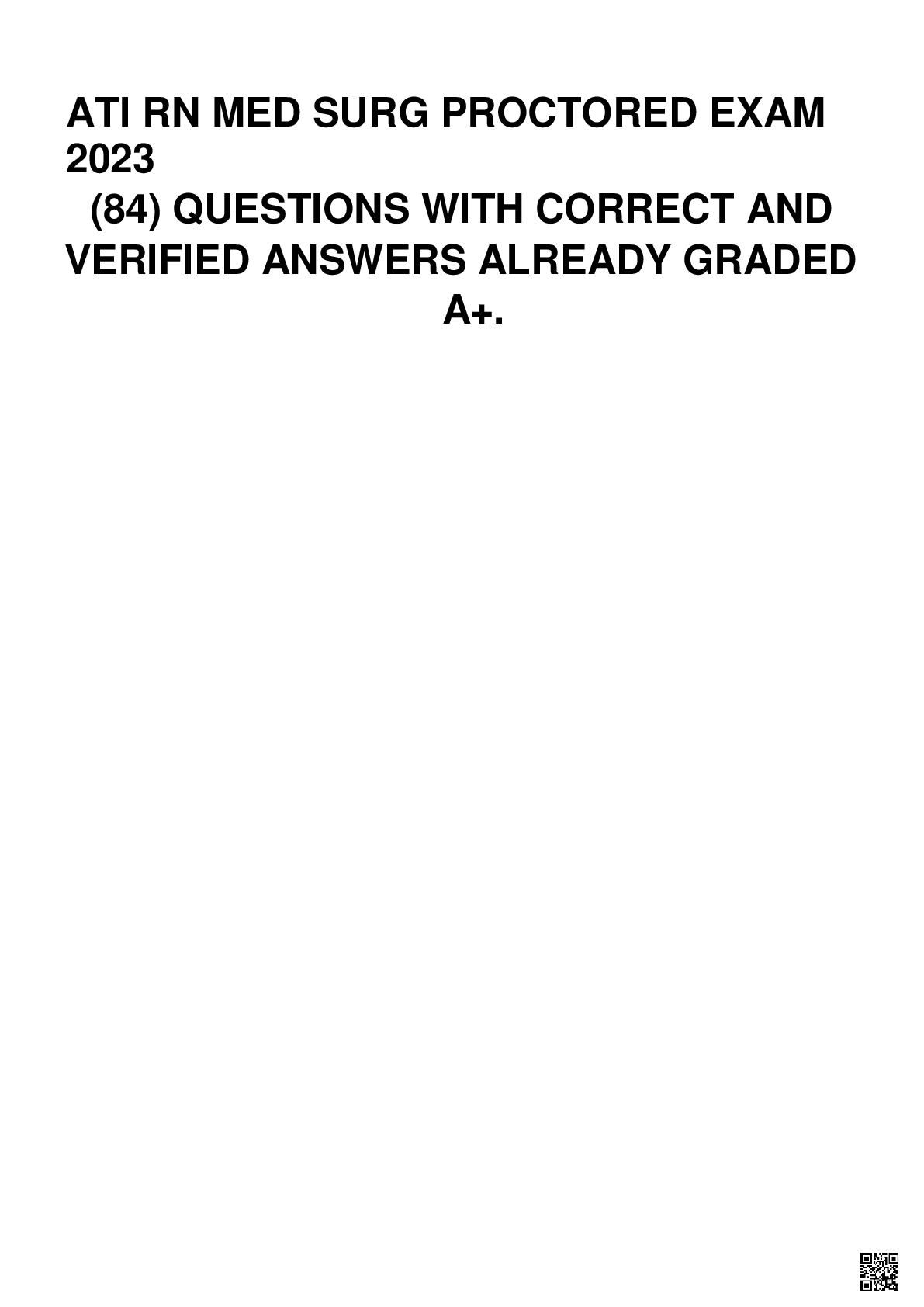
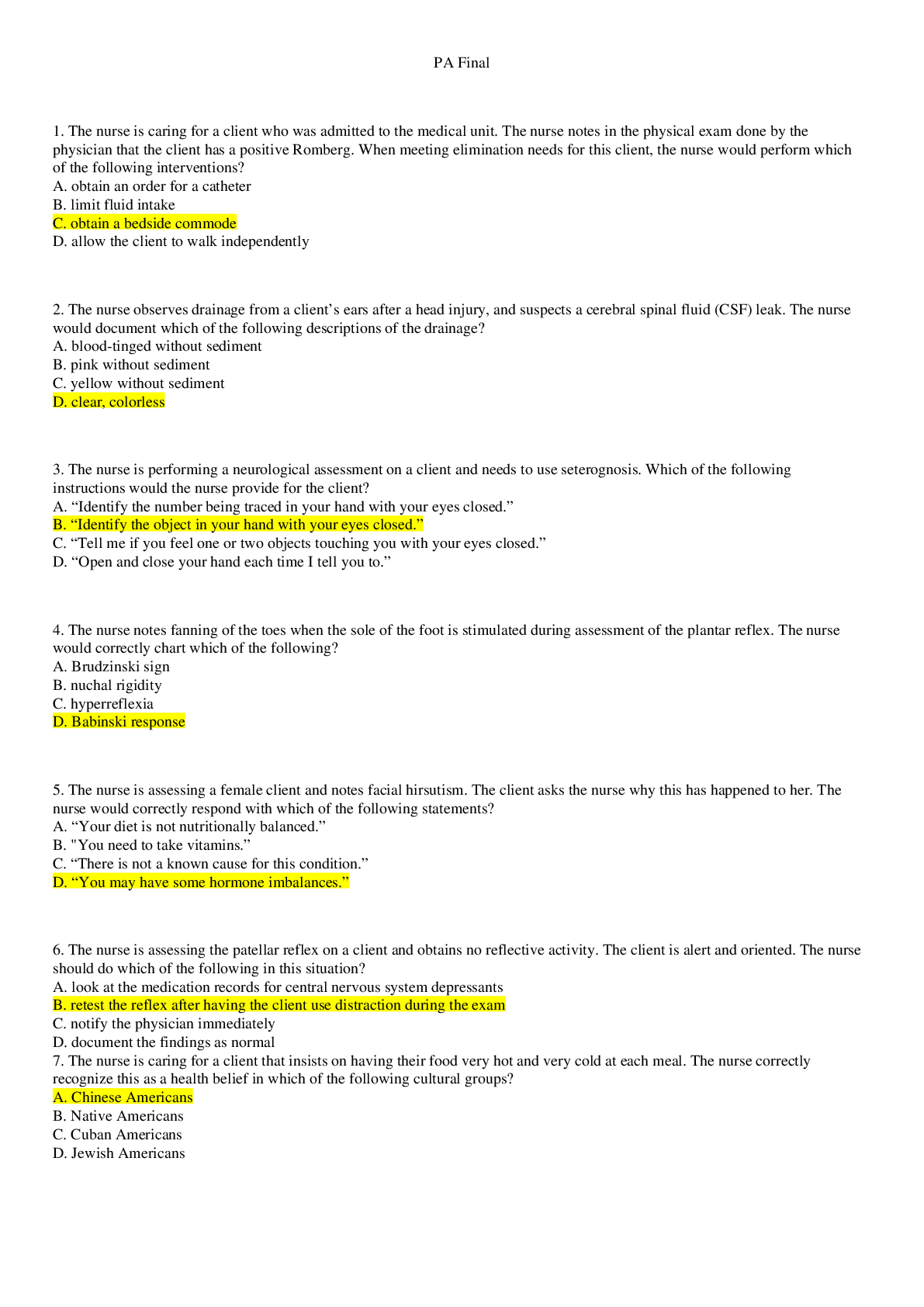
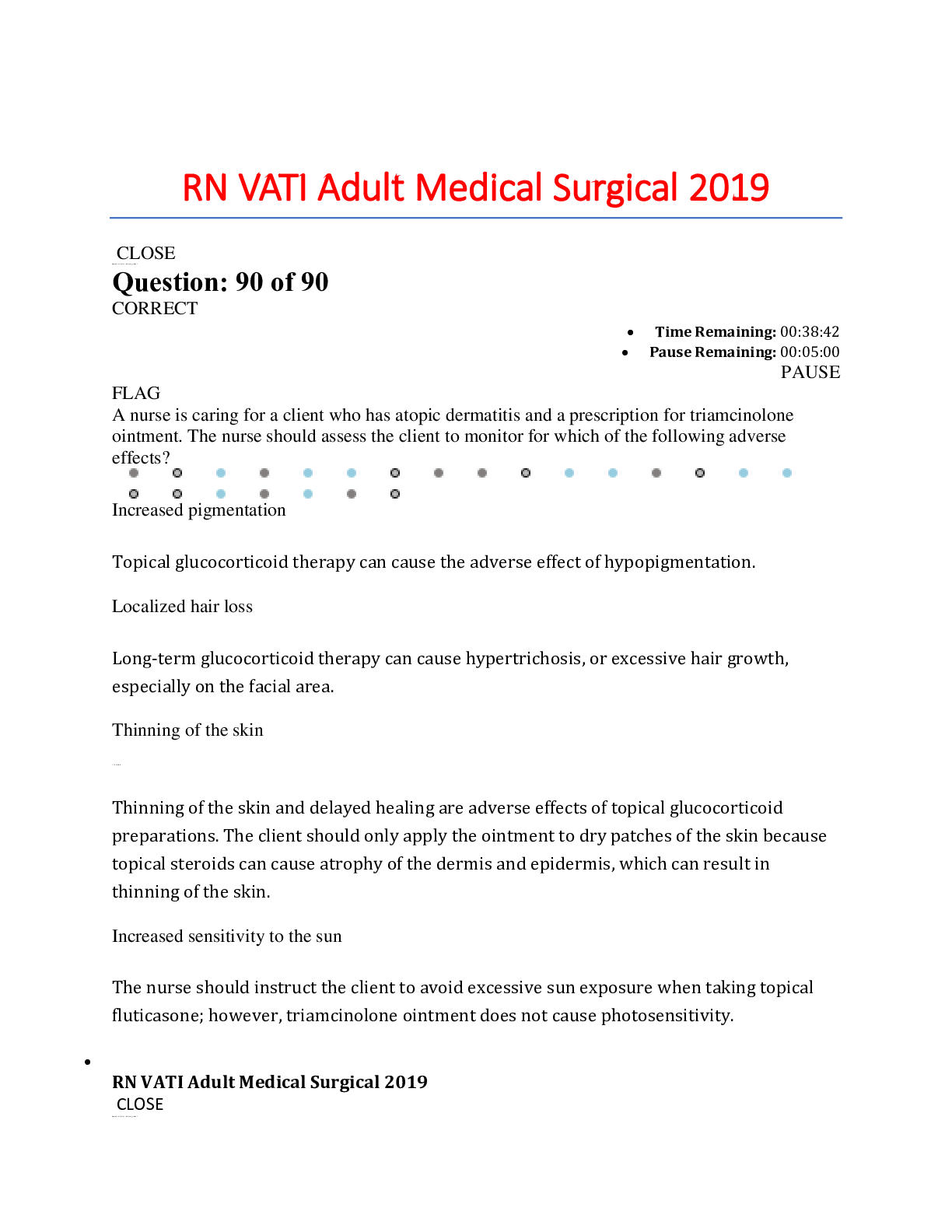
.png)
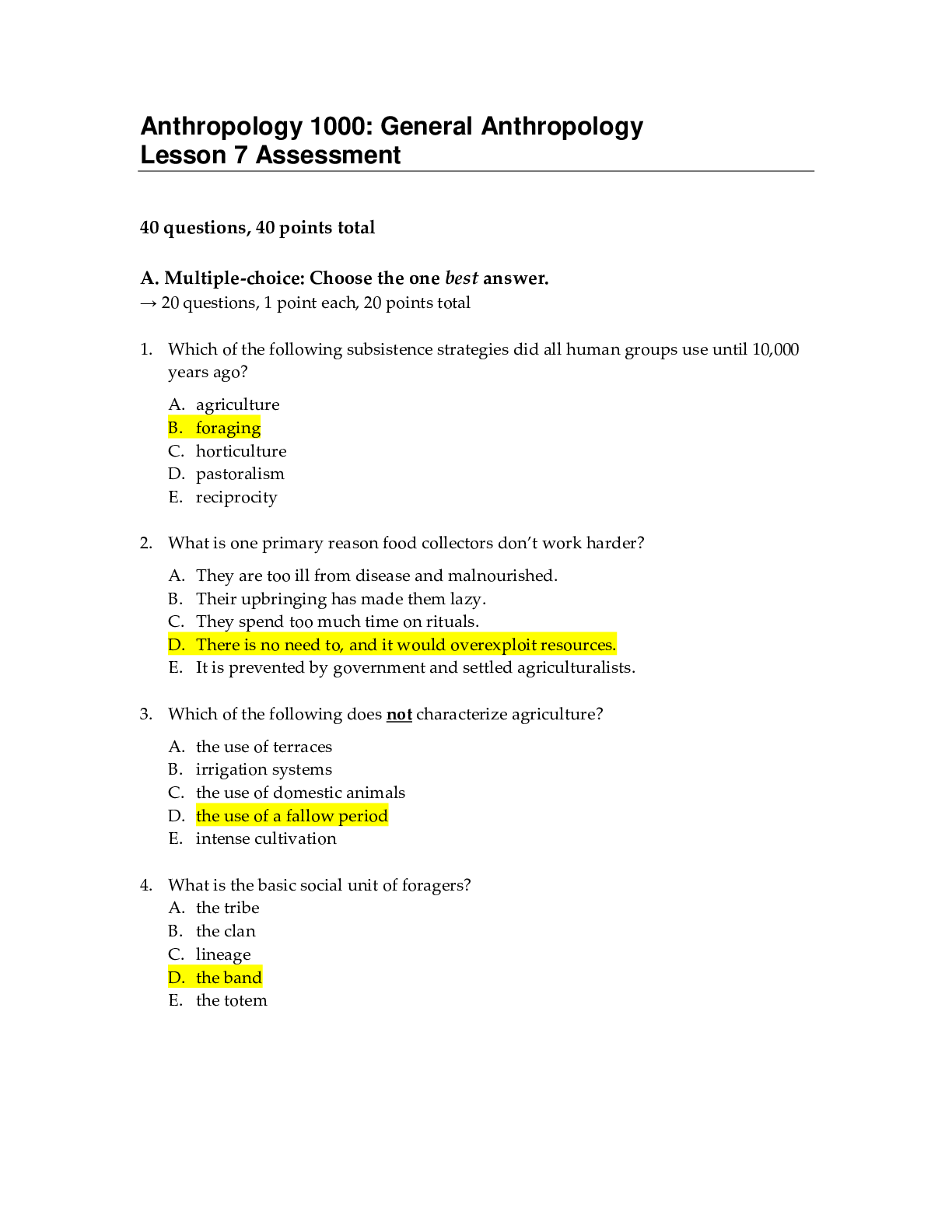
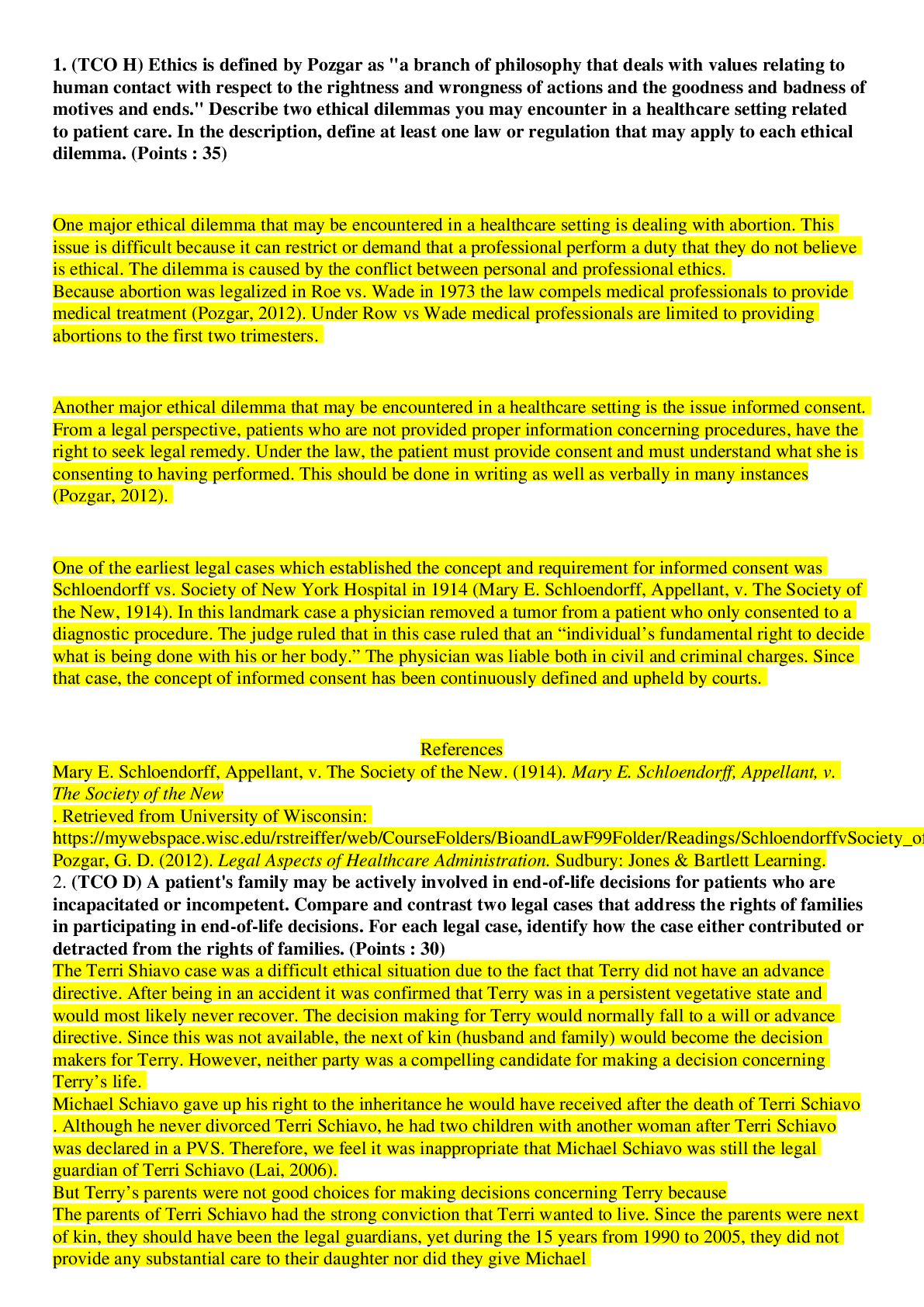
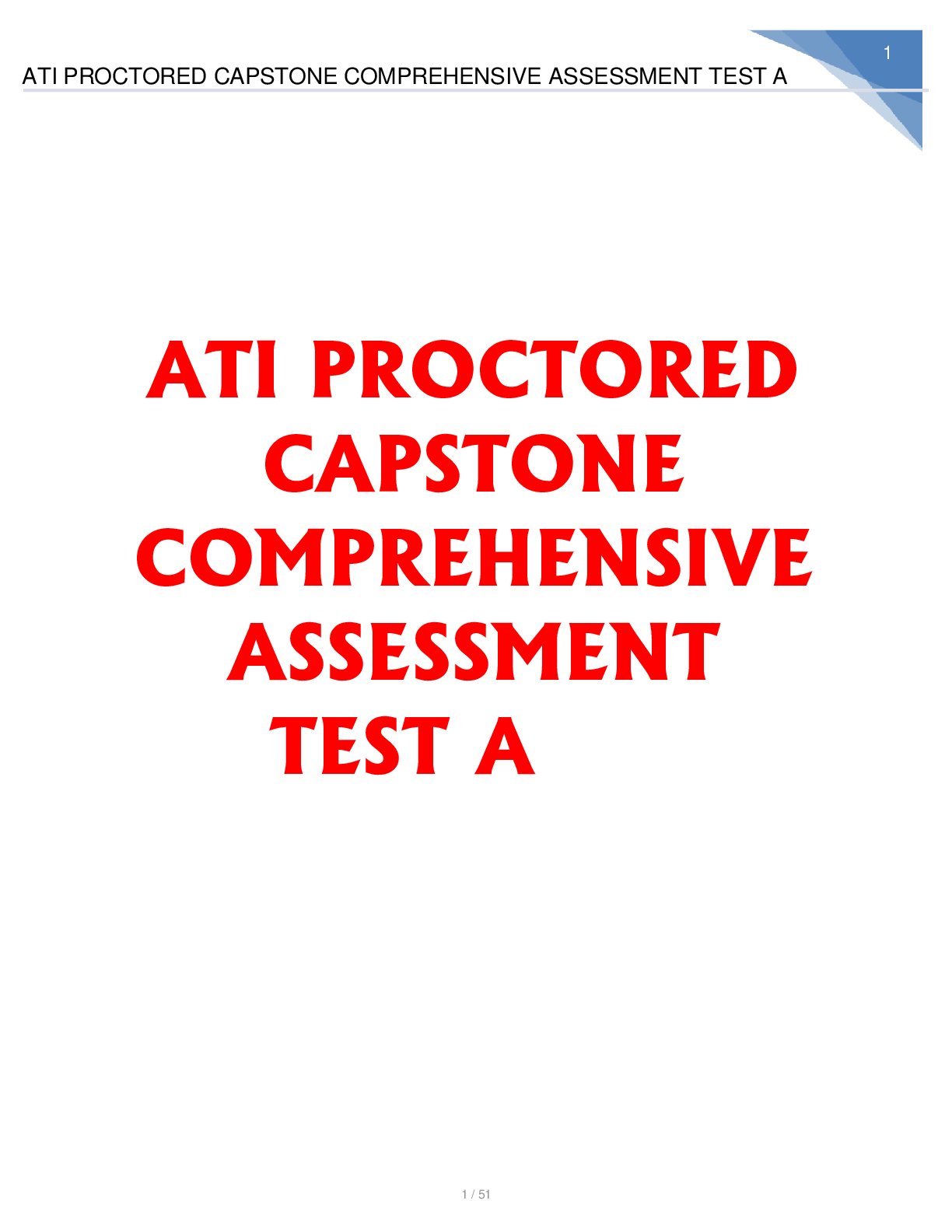
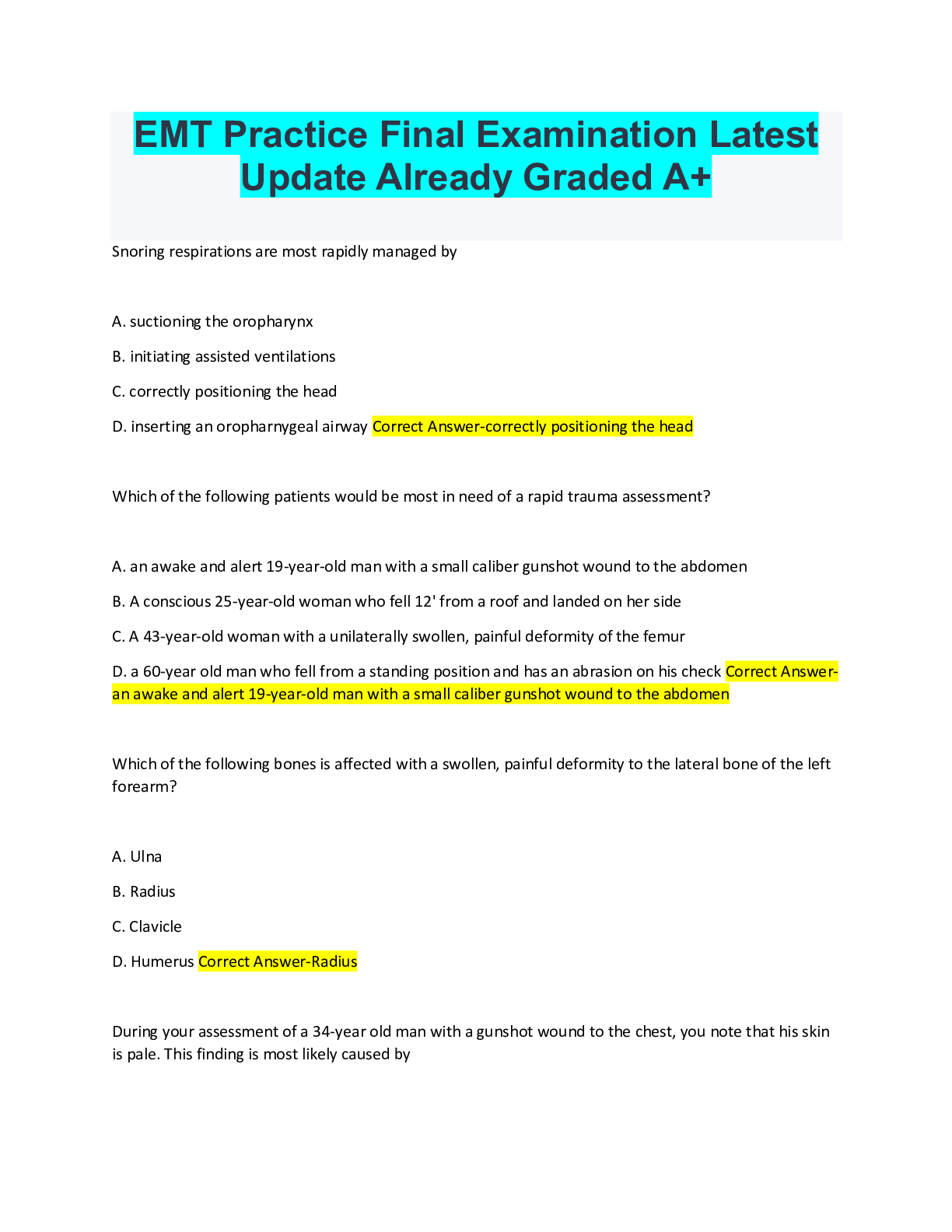
.png)
 Exam 2022 Questions & Answers.png)


